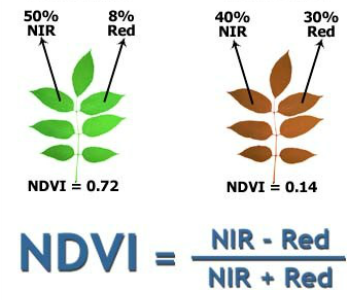Normalized Difference Vegetation Index or NDVI is an imaging processing product that is able to distinguish between weeds and ripe crops based on their reflection of red and near infrared light (NIR). Green plants reflect much of the near infrared light and very little of the red light, while brown plants reflects more red light and less near infrared light. By taking the ratio of red and near infrared reflectance an index of vegetation :greenness" can be defined; a low NDVI value indicates the plant is brown, while a high NDVI value indicates the plant is green.
For our project a NDVI value of 0.2 or lower indicates a ripe grain crop which are a uniform yellow/brown color during harvest, while a NDVI value of 0.5 or higher indicates a green weed. Using the NDVI imaging system we will then be able to effectively map the problem areas of weeds within a large grain field.
For our project a NDVI value of 0.2 or lower indicates a ripe grain crop which are a uniform yellow/brown color during harvest, while a NDVI value of 0.5 or higher indicates a green weed. Using the NDVI imaging system we will then be able to effectively map the problem areas of weeds within a large grain field.
